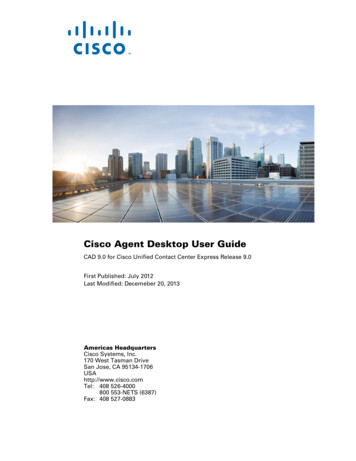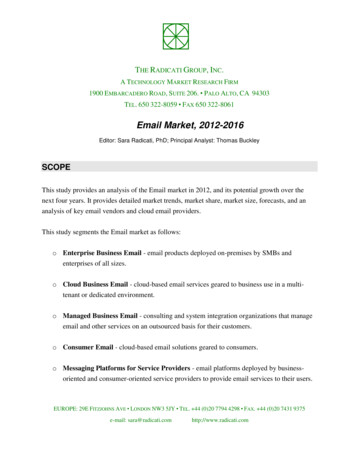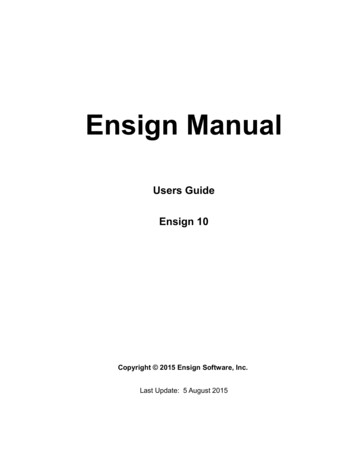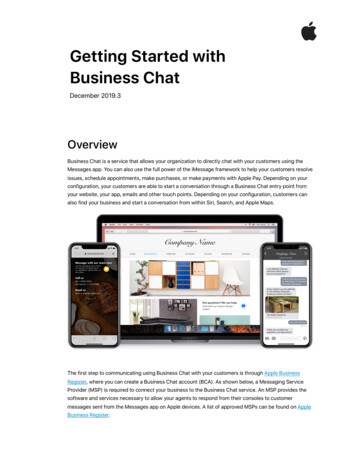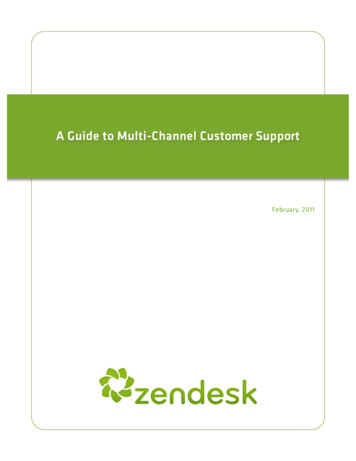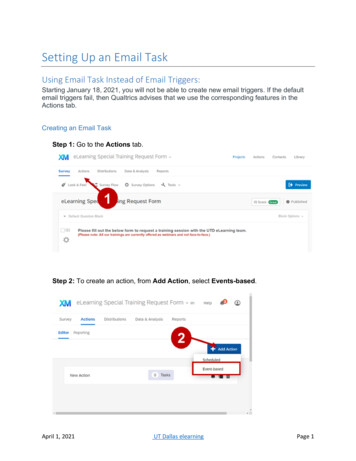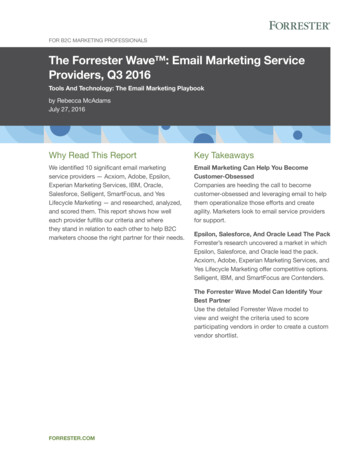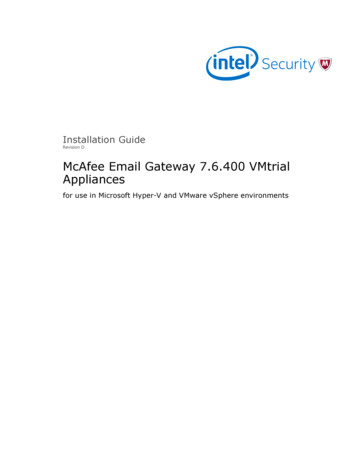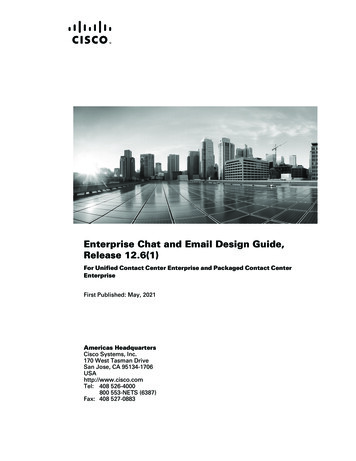
Transcription
Enterprise Chat and Email Design Guide,Release 12.6(1)For Unified Contact Center Enterprise and Packaged Contact CenterEnterpriseFirst Published: May, 2021Americas HeadquartersCisco Systems, Inc.170 West Tasman DriveSan Jose, CA 95134-1706USAhttp://www.cisco.comTel: 408 526-4000800 553-NETS (6387)Fax: 408 527-0883
THE SPECIFICATIONS AND INFORMATION REGARDING THE PRODUCTS IN THIS MANUAL ARE SUBJECT TO CHANGE WITHOUT NOTICE. ALLSTATEMENTS, INFORMATION, AND RECOMMENDATIONS IN THIS MANUAL ARE BELIEVED TO BE ACCURATE BUT ARE PRESENTED WITHOUTWARRANTY OF ANY KIND, EXPRESS OR IMPLIED. USERS MUST TAKE FULL RESPONSIBILITY FOR THEIR APPLICATION OF ANY PRODUCTS.THE SOFTWARE LICENSE AND LIMITED WARRANTY FOR THE ACCOMPANYING PRODUCT ARE SET FORTH IN THE INFORMATION PACKET THATSHIPPED WITH THE PRODUCT AND ARE INCORPORATED HEREIN BY THIS REFERENCE. IF YOU ARE UNABLE TO LOCATE THE SOFTWARE LICENSEOR LIMITED WARRANTY, CONTACT YOUR CISCO REPRESENTATIVE FOR A COPY.The Cisco implementation of TCP header compression is an adaptation of a program developed by the University of California, Berkeley (UCB) as part of UCBs publicdomain version of the UNIX operating system. All rights reserved. Copyright 1981, Regents of the University of California.NOTWITHSTANDING ANY OTHER WARRANTY HEREIN, ALL DOCUMENT FILES AND SOFTWARE OF THESE SUPPLIERS ARE PROVIDED "AS IS" WITHALL FAULTS. CISCO AND THE ABOVE-NAMED SUPPLIERS DISCLAIM ALL WARRANTIES, EXPRESSED OR IMPLIED, INCLUDING, WITHOUTLIMITATION, THOSE OF MERCHANTABILITY, FITNESS FOR A PARTICULAR PURPOSE AND NONINFRINGEMENT OR ARISING FROM A COURSE OFDEALING, USAGE, OR TRADE PRACTICE.IN NO EVENT SHALL CISCO OR ITS SUPPLIERS BE LIABLE FOR ANY INDIRECT, SPECIAL, CONSEQUENTIAL, OR INCIDENTAL DAMAGES, INCLUDING,WITHOUT LIMITATION, LOST PROFITS OR LOSS OR DAMAGE TO DATA ARISING OUT OF THE USE OR INABILITY TO USE THIS MANUAL, EVEN IF CISCOOR ITS SUPPLIERS HAVE BEEN ADVISED OF THE POSSIBILITY OF SUCH DAMAGES.Any Internet Protocol (IP) addresses and phone numbers used in this document are not intended to be actual addresses and phone numbers. Any examples, command displayoutput, network topology diagrams, and other figures included in the document are shown for illustrative purposes only. Any use of actual IP addresses or phone numbers inillustrative content is unintentional and coincidental.Cisco and the Cisco logo are trademarks or registered trademarks of Cisco and/or its affiliates in the U.S. and other countries. To view a list of Cisco trademarks, go tohttp://www.cisco.com/go/trademarks. Third-party trademarks mentioned are the property of their respective owners. The use of the word partner does not imply a partnershiprelationship between Cisco and any other company. (1110R)Enterprise Chat and Email Design Guide: For Unified Contact Center Enterprise. February 2, 2022Copyright 2016–2021, Cisco Systems, Inc. All rights reserved.
ContentsPreface .5About This Guide . . . . . . . . . . . . . . . . . . . . . . . . . . . . . . . . . . . . . . . . . . . . . . . . . . . . . . . . 6Related Documents . . . . . . . . . . . . . . . . . . . . . . . . . . . . . . . . . . . . . . . . . . . . . . . . . . . . . . . 6Communications, Services, and Additional Information . . . . . . . . . . . . . . . . . . . . . . . . . . 6Cisco Bug Search Tool . . . . . . . . . . . . . . . . . . . . . . . . . . . . . . . . . . . . . . . . . . . . . . . . . 7Documentation Feedback . . . . . . . . . . . . . . . . . . . . . . . . . . . . . . . . . . . . . . . . . . . . . . . . . . 7Field Alerts and Field Notices . . . . . . . . . . . . . . . . . . . . . . . . . . . . . . . . . . . . . . . . . . . . . . 7Document Conventions. . . . . . . . . . . . . . . . . . . . . . . . . . . . . . . . . . . . . . . . . . . . . . . . . . . . 7Chapter 1: System Flow and Configuration Design.8Email Routing Through Unified CCE . . . . . . . . . . . . . . . . . . . . . . . . . . . . . . . . . . . . . . . . 9Chat Routing Through Unified CCE . . . . . . . . . . . . . . . . . . . . . . . . . . . . . . . . . . . . . . . . 10Callback Routing Through Unified CCE . . . . . . . . . . . . . . . . . . . . . . . . . . . . . . . . . . . . . 11Designing Integrated Routing - An Example . . . . . . . . . . . . . . . . . . . . . . . . . . . . . . . . . . 11Unified CCE Configuration . . . . . . . . . . . . . . . . . . . . . . . . . . . . . . . . . . . . . . . . . . . . 11Configuration in ECE . . . . . . . . . . . . . . . . . . . . . . . . . . . . . . . . . . . . . . . . . . . . . . . . . 12Chapter 2: Sizing Guidelines .14Sizing Inputs . . . . . . . . . . . . . . . . . . . . . . . . . . . . . . . . . . . . . . . . . . . . . . . . . . . . . . . . . . . 15Planning for Database Growth . . . . . . . . . . . . . . . . . . . . . . . . . . . . . . . . . . . . . . . . . . . . . 15About Deploying on Virtual Servers . . . . . . . . . . . . . . . . . . . . . . . . . . . . . . . . . . . . . . . . 16Sizing for Combined Email, Web, and Voice Scenarios . . . . . . . . . . . . . . . . . . . . . . . . . 16Important Information About Sizing. . . . . . . . . . . . . . . . . . . . . . . . . . . . . . . . . . . . . . 16Support for up to 400 Standardized Concurrent Agents . . . . . . . . . . . . . . . . . . . . . . . 17Support for 401 to 1500 Standardized Concurrent Agents . . . . . . . . . . . . . . . . . . . . . 17Additional Configurations for Sizing . . . . . . . . . . . . . . . . . . . . . . . . . . . . . . . . . . . . . . . . 17Expanding the Disk Size on Database Server Machines. . . . . . . . . . . . . . . . . . . . . . . 17
Chapter 3: Fault Tolerance and Redundancy .19Load Balancing Considerations . . . . . . . . . . . . . . . . . . . . . . . . . . . . . . . . . . . . . . . . . . . . 20High Availability Options. . . . . . . . . . . . . . . . . . . . . . . . . . . . . . . . . . . . . . . . . . . . . . . . . 21Managing Failover . . . . . . . . . . . . . . . . . . . . . . . . . . . . . . . . . . . . . . . . . . . . . . . . . . . . . . 22Chapter 4: Network Latency.24Network Latency. . . . . . . . . . . . . . . . . . . . . . . . . . . . . . . . . . . . . . . . . . . . . . . . . . . . . . . . 25Bandwidth Requirements . . . . . . . . . . . . . . . . . . . . . . . . . . . . . . . . . . . . . . . . . . . . . . . . . 25Geographic Server Distribution . . . . . . . . . . . . . . . . . . . . . . . . . . . . . . . . . . . . . . . . . . . . 25Chapter 5: Firewall and Hardening .26Firewall Considerations . . . . . . . . . . . . . . . . . . . . . . . . . . . . . . . . . . . . . . . . . . . . . . . . . . 27Server Hardening Considerations . . . . . . . . . . . . . . . . . . . . . . . . . . . . . . . . . . . . . . . . . . . 27Default Windows and IIS Service Requirements for ECE . . . . . . . . . . . . . . . . . . . . . 27Guidelines for Microsoft SQL Server . . . . . . . . . . . . . . . . . . . . . . . . . . . . . . . . . . . . . 284 Enterprise Chat and Email Design Guide
Preface About This Guide Communications, Services, and Additional Information Documentation Feedback Field Alerts and Field Notices Document Conventions
Welcome to the Enterprise Chat and Email (ECE) feature, which provides multichannel interaction softwareused by businesses all over the world as a core component to the Unified Contact Center Enterprise product line.ECE offers a unified suite of the industry’s best applications for chat and email interaction management toenable a blended agent for handling of web chat, email and voice interactions.About This GuideEnterprise Chat and Email Design Guide is intended for engineers, system architects, and other technicalaudience responsible for planning the deployment and maintenance of Enterprise Chat and Email for CiscoUnified Contact Center Enterprise (Unified CCE) and Cisco Packaged Contact Center Enterprise (PCCE).The document is designed to provide an overview of the system flow for different types of interactions, sizingguidelines, load-balancing options, network latency considerations, firewall considerations, and interfaceboundaries.For sizing guidelines for servers used in the Unified CCE deployment, refer to the Unified CCE SRND guideavailable here: https://www.cisco.com/go/srnd.Related DocumentsThe latest versions of all Cisco documentation can be found online at http://www.cisco.comSubjectLinkComplete documentation for EnterpriseChat and Email, for both Cisco UnifiedContact Center Enterprise (UCCE) and CiscoPackaged Contact Center Enterprise oducts-support-series-home.htmlCommunications, Services, and AdditionalInformation To receive timely, relevant information from Cisco, sign up at Cisco Profile Manager. To get the business impact you’re looking for with the technologies that matter, visit Cisco Services. To submit a service request, visit Cisco Support. To discover and browse secure, validated enterprise-class apps, products, solutions and services, visit CiscoMarketplace. To obtain general networking, training, and certification titles, visit Cisco Press. To find warranty information for a specific product or product family, access Cisco Warranty Finder.6 Enterprise Chat and Email Design Guide
Cisco Bug Search ToolCisco Bug Search Tool (BST) is a web-based tool that acts as a gateway to the Cisco bug tracking system thatmaintains a comprehensive list of defects and vulnerabilities in Cisco products and software. BST provides youwith detailed defect information about your products and software.Documentation FeedbackTo provide comments about this document, send an email message to the following address:contactcenterproducts docfeedback@cisco.comWe appreciate your comments.Field Alerts and Field NoticesCisco products may be modified or key processes may be determined to be important. These are announcedthrough use of the Cisco Field Alerts and Cisco Field Notices. You can register to receive Field Alerts and FieldNotices through the Product Alert Tool on Cisco.com. This tool enables you to create a profile to receiveannouncements by selecting all products of interest.Log into www.cisco.com and then access the tool at tmlDocument ConventionsThis guide uses the following typographical conventions.ConventionIndicatesItalicEmphasis.Or the title of a published document.BoldLabels of items on the user interface, such as buttons, boxes, and lists.Or text that must be typed by the user.MonospaceThe name of a file or folder, a database table column or value, or a command.VariableUser-specific text; varies from one user or installation to another.Document conventionsPreface7
System Flow andConfigurationDesign Email Routing Through Unified CCE Chat Routing Through Unified CCE Callback Routing Through Unified CCE Designing Integrated Routing - An Example
This chapter illustrates the major components involved in the life-cycle of email, callback, and chat activities asthey move through the system. It includes the various steps in the handling of an interaction from the point atwhich a customer query is received to it being routed to the appropriate user or queue.Email Routing Through Unified CCEThere are various steps involved in efficiently responding to emails from customers. Emails are first retrievedinto the system and routed to appropriate users or queues. Once a response is created, it is processed through thesystem and sent to the customer. The general system flow for integrated email routing is described in thissection.General system flow for email routingSystem Flow and Configuration Design9
Chat Routing Through Unified CCEThere are various steps involved in efficiently responding to chat requests received from customers. The generalsystem flow for handling a chat request in a system integrated with Unified CCE (Enterprise and Packaged) isincluded here.General system flow for chat routing10
Callback Routing Through Unified CCECallback allows customers to submit a phone number using a web form. An agent who can handle the call isidentified, and a call is placed, connecting the agent to the customer. The call back can happen right away, orafter a period of time chosen by the customer.System flow for web and delayed callbackDesigning Integrated Routing - An ExampleThis section includes a sample integrated routing scenario and some best practices around creating MRDs andskill groups for a deployment with blended agents.The following example shows an email deployment, but is also relevant for chat.Unified CCE ConfigurationThe following objects are configured in Unified CCE.1.One media routing domain for emails: Email MRD.2.Two peripherals: NA Peripheral, and EMEA Peripheral.System Flow and Configuration Design11
3.The peripheral to skill group to agent relationship is as follows. All eight skill groups are associated with theEmail MRD.PeripheralSkill GroupAgentsNA PeripheralDomestic Sales NAClark, BruceGlobal Sales NAClarkDomestic Support NAPeterGlobal Support NATonyDomestic Sales EMEANatasha, ClintGlobal Sales EMEANatashaDomestic Support EMEALokiGlobal Support EMEALoki, PhilEMEA Peripheral4.Configured scripts route to the appropriate skill groups as follows.ScriptSkill GroupGlobal Sales Email ScriptGlobal Sales NAGlobal Sales EMEAGlobal Support Email ScriptGlobal Support NAGlobal Support EMEADomestic Sales Email ScriptDomestic Sales NADomestic Sales EMEADomestic Support Email ScriptDomestic Support NADomestic Support EMEAConfiguration in ECE1.Two departments are configured in ECE, one each for Sales and Support. Both use the same single MRD,Email MRD.2.The Sales department has two queues, one each for each of the script selectors for sales (global anddomestic). Similarly, the Support department also has two queues. Note that by default, when an MRDisimported into ECE, queues are created using the following naming convention MRDName ScriptSelectorName . All queue names are editable. For details about queues, see theEnterprise Chat and Email Administrator’s Guide to Routing and Workflows.In this scenario, the department to queue to skill group mapping, and the agents who service activities is asfollows:12
DepartmentQueueSalesEmail MRD Domestic Sales Email ScriptEmail MRD Global Sales Email ScriptMapped Skill GroupsDomestic Sales NAAgents Who ServiceActivitiesDomestic Sales EMEAClark, Bruce, Natasha,ClintGlobal Sales NAClark, NatashaGlobal Sales EMEASupportEmail MRD Domestic Support Email ScriptDomestic Support NAPeter, LokiDomestic Support EMEAEmail MRD Global Support Email ScriptGlobal Support NAPeter, Loki, PhilGlobal Support EMEAAlthough this example does not use precision queues, you can extend the design to include them. Ensure that theappropriate precision queues are associated with the correct queues in ECE to make sure that activities are routedto the correct agent.To keep the design simple yet effective, here are some general guidelines to follow while designing a system forunified routing:1.Create one MRD per channel, for example, one for incoming email, one for outgoing email, one for chat andone for callback. Note that email MRDs are always interruptible in ECE.2.Do not share skill groups and precision queues across departments.3.While associating skill groups with queues in ECE, ensure that the association matches the skill groupsselected in the queue to skill group node of the script selector.4.While associating precision queues with queues in ECE, ensure that the association matches the PQassociation with the script selector.System Flow and Configuration Design13
SizingGuidelines Sizing Inputs Planning for Database Growth About Deploying on Virtual Servers Sizing for Combined Email, Web, and Voice Scenarios Additional Configurations for Sizing
Sizing InputsConfigurations presented in the following sections provide sizing for standardized agents who handle up to 6email messages per hour, or one chat session at a time. If agents are expected to handle more than 6 emailmessages per hour, on average, or more than one chat session at a time, convert the agent count into astandardized agent count using the following formula:Email:Standardized agent count for email Actual agent count * Average number ofmessages handled per hour by each agent / 6Chat:Standardized agent count for chat Actual agent count * Average number ofconcurrent chat sessions handled by each agentEmail and Chat:Standardized agent count Standardized agent count for email Standardizedagent count for chatUse the standardized agent count to find the appropriate configuration to fit your needs. For sizing for CombinedEmail, Chat, and Voice Scenarios, see page 16.Important: The number of concurrent agents per application server cannot exceed 400, as this isthe maximum number of concurrent agents that can be supported for email and chat by one ECEserver in a deployment of ECE.Planning for Database GrowthThe following factors are considered for calculating the rate of growth of database. Incoming and outgoing email volume per month. Number of email attachments Average size of each email (KB).The following formula can be used to compute the approximate rate of growth of the database server (MB) permonth for activities of type email:((Number of incoming and outgoing emails per month * 2) * (6 (Average size ofeach email message in KB * 2)) / 1024If your system receives emails with attachments, use the following formula and add it to the value for emails.((Number of emails per month with attachments * Average size of attachments(K))/1024)For example, if average volume of incoming and outgoing emails with attachments is 50,000, and average sizeof each attachment is 5 KB, monthly rate of growth can be computed as:((50,000 * 5) /1024) 245 MB per monthSizing Guidelines 15
The following formula can be used to compute the approximate rate of growth of the database server (MB) permonth for activities of type chat or callback:((Number of incoming and outgoing chat messages per month) * (6 (Average size ofeach chat message in KB * 3 * 2)) / 1024Important: These formulas are meant to be used to plan for database growth. Values arrived atusing computation may not be an exact match to actual sizesAbout Deploying on Virtual ServersAll components in the ECE deployment must be installed on virtual servers that utilize the OVA templatesavailable cisco.com for proper sizing and resource utilization. For details seehttps://www.cisco.com/c/dam/en/us/td/docs/voice ip comm/uc t-email.html. Navigate to the section for Enterprise Chat and Email 12.0. Note that deployments using theEnterprise edition of SQL Server can expand the size of the database server disk to support growth in data overtime. Since the application leverages the partitioning capabilities of the enterprise editions, data is not archivedand purged from the databases. For details about increasing the disk size, see “Expanding the Disk Size onDatabase Server Machines” on page 17.For details about implementing a deployment on virtual servers, see Sizing for Combined Email, Web, and VoiceScenariosECE can support multiple media, namely, email, chat, and callback. The following combinations of users can besupported on respective configurations described here.Important Information About Sizing For a distributed deployment, the concurrent load must be spread evenly across all the web-applicationservers in the cluster. In the sizing configurations described here, dual CPU can optionally be replaced by 2 single core CPUs anda quad CPU can optionally be replaced by a 4 single core CPUs. Sizing is not affected by the existence of a firewall between the web server and the application server, andby whether the web and application servers are collocated or not. The application leverages the partitioning capabilities of SQL Server, so no specific action—other thanincreasing the disk space as needed —is required to manage data growth.16Enterprise Chat and Email Design Guide
Support for up to 400 Standardized Concurrent AgentsSupport for up to 400 concurrent agents handling email, chat, or callback, where each agent can work on emailsat the rate of 6 emails per hour, or work on a single active chat or callback session, at the rate of 6 chat sessionsper hour. Configuration supports an incoming email rate of up to 120,000 emails per month.In ECE, any combination of agent-customer chat sessions, callback sessions, and email activities agents totalingto 400, can be supported on a two-server configuration consisting of one web server, and another server with theweb, application, file, messaging, services, and database components.This configuration also requires two workflow processes and instances to be configured in the application. Fordetails see the Enterprise Chat and Email Administrator’s Guide to System Resources.To deploy this configuration, use the following OVA template: ECE 12.6 400 Win2019 vmv13 v1.0.ovaSupport for 401 to 1500 Standardized Concurrent AgentsSupport for 401 to 1500 concurrent agents handling email, chat, or callback, where each agent can work onemails at the rate of 6 emails per hour, or work on a single active chat or callback session, at the rate of 6 chatsessions per hour.This is supported on a configuration consisting of five web servers, five application servers, one file server, onemessaging server, one services server, and one database server. Load must be evenly distributed across the webservers.This configuration also requires two workflow processes and instances to be configured in the application. Fordetails see the Enterprise Chat and Email Administrator’s Guide to System Resources.To deploy this configuration, use the following OVA template: ECE 12.6 1500 Win2019 vmv13 v1.0.ovaAdditional Configurations for SizingExpanding the Disk Size on Database Server MachinesOver time as the data in your databases grows, you will need to increase the disk space on the database servermachines. Follow the instructions provided by VMWare to increase the size of the disk on all the machines onwhich the data files for the active, master, and reports databases are installed.Before you increase the disk space, complete the following tasks Stop the application Stop SQL ServerNow expand the disk space on the servers where the data files are installed following the VMWare guidelines foryour particular operating system. Additional information is available d displayKC&docType kc&docTypeID DT KB 1 1&externalId 1004071After you expand the size, complete the following tasksSizing Guidelines 17
Restart the Windows server Log into the database server where the data files reside and ensure that the disk space has been expanded tothe new and increased size Restart SQL Server Restart the application on all the servers in the deployment18Enterprise Chat and Email Design Guide
Fault Tolerance andRedundancy Load Balancing Considerations High Availability Options Managing Failover
To optimize resource utilization and enhance performance, access to the application can be set up for faulttolerance and redundancy.Load Balancing ConsiderationsThe web service component of a ECE deployment can be load-balanced to serve large number of agentsaccessing the application at the same time. The web (or web-application) servers can be configured behind theload balancer with a virtual IP address, and a user can access ECE through this IP address. Depending on theload balancing algorithm set, the load balancer will send a request to one of the web-application server behind itand send a response back to the user. This way, from a security perspective, the load balancer serves as a reverseproxy server too.One of the most essential parameters while configuring a load balancer is to configure it to support stickysessions with cookie based persistence. After every scheduled maintenance task, before access is opened forusers, it is advised to verify that all web-application servers are available to share the load. In absence of this, thefirst web-application server could be overloaded, due to the sticky connection feature. With other configurableparameters, one can define load balancing algorithms to meet various objectives such as equal load balance,isolation of a web-application server, or sending lesser requests to a low powered web-application servers.The load balancer monitors the health of all web-application servers in the cluster, and if a problem is observed,the load balancer removes the given web-application server from the available pool of servers, thus preventingnew web requests from being directed to the problematic web-application servers.20Enterprise Chat and Email Design Guide
High Availability OptionsBased on typical customer deployment scenarios, the following recommendations apply towards achieving ahigh-available system deployment.Fault Tolerance and Redundancy 21
AspectDescriptionAdvantagesLoad BalancerThe load balancer is used for distributing webrequests across different web servers. Various typesof load balancers are available in the industry. Eachof these could be configured with different optionsfor work distribution, handling failures, or increasedactivity. Helps distribute load across different servers. Helps configure load distribution based on serverThe network is a key ingredient to a successful andhighly available application. When agents connect tothe application remotely, the permissible networklatency is 300 milliseconds (one way). Higher latencybetween the agents and the applications serverscould lead to slower performance on the agentinterface. Stable network connections for distributedIt is highly recommended that more than 1 webapplication server be configured. More than one web-application server helps toHigh-SpeedDedicated LANConfiguring morethan one webapplication serverConfiguringclustering forMessaging ServersThe load balancer detects web server failures andredirects requests to other available web servers,after which, users will have to re-login to theapplication and a new user session will be createdon the target web server.A cluster of messaging servers can be installed toachieve failover. When the application starts, itconnects to one messaging server in the cluster. Ifthis server goes down the application automaticallyconnects to the next available messaging server inthe cluster.capacity and current server resources. Helps handle failures by alternate means ofrouting a web request.components. Helps serve web requests in a more predictableand reliable manner. Less delay in responses and thereby increasesuser experience.load balance web requests to multiple serversbased on both system load and availability ofservers. Helps the system scale better to meet growingneeds of the enterprise. Application continues to be available even whenone messaging server goes down. If the messaging server is installed on a separatemachine, it can be restarted without affectingany other components in the deployment.Once a server in the cluster becomes unavailable ithas to be restarted manually.Configuring Primaryand SecondaryServices serversConfiguring AlwaysOn for databasesTwo services server components, one primary andone secondary can be installed to achieve failover.Both components stay active, and when the primarygoes down, the secondary services serverautomatically takes over. The application continues to process activitieseven when a services server component goesdown Removes single points of failure from thedeployment.MS SQL Server Always On is supported and can beconfigured to achieve high availability for the ECEdatabases.Recommendations for high availability needsIn addition to these recommendations, if a load balancer is configured to monitor the health of web-applicationservers, it also serves the purpose of high availability.Managing FailoverSome of the key methods of handling failure conditions within an ECE and Unified CCE or Packaged CCEintegrated deployment are listed here.22Enterprise Chat and Email Design Guide
Web and Application Servers: Multiple web-application servers can be deployed in any distributed serverdeployment. If any of the web-application servers go down, a load balancer can help handle the failurethrough routing requests to alternate web-application servers. The load balancer detects application serverfailure and redirects requests to another application server. Users can log into the application withoutexperiencing any significant loss of productivity.Also note that in deployments without a loadbalancer, if one or more application servers crash, the entireapplication does not need to be restarted. Only the affected application servers have to be restarted. The restof the application continues to function normally. File, Services and Messaging Servers: ECE is certified with VMware versions that support VMware HighAvailability. When VMware HA is configured, automatic failover is managed by VMware.For the Messaging server, a cluster of messaging servers can also be configured for fail-over acrossgeographies. For details on configuring failover see the installation guides.For the Services server, the active-active m
Unified Contact Center Enterprise (Unified CCE) and Cisco Packaged Contact Center Enterprise (PCCE). The document is designed to provide an overview of the system flow for different types of interactions, sizing guidelines, load-balancing options, network latency considera
